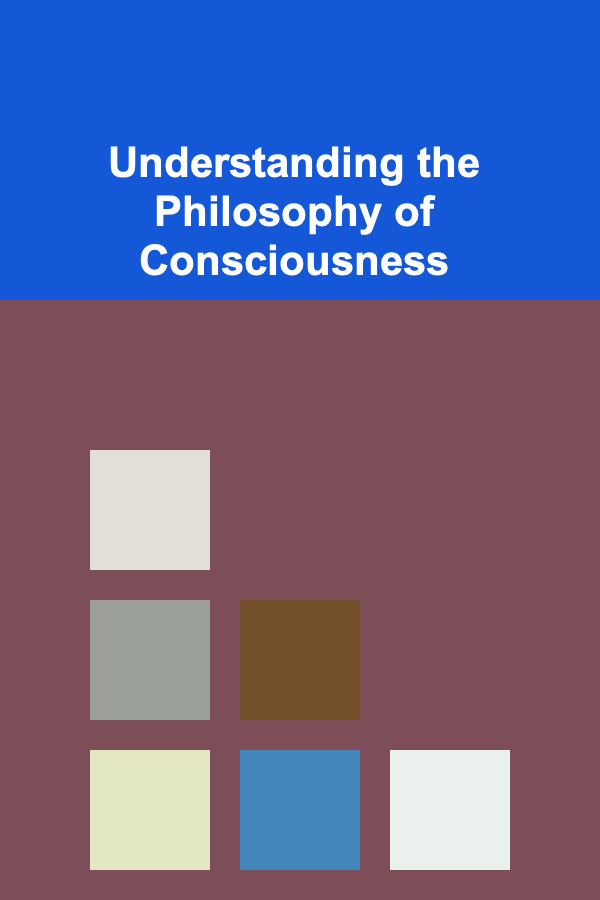
Understanding the Philosophy of Consciousness
ebook include PDF & Audio bundle (Micro Guide)
$12.99$6.99
Limited Time Offer! Order within the next:

Consciousness, the subjective quality of experience, is arguably the most profound and perplexing mystery confronting science and philosophy. It encompasses everything from the simple feeling of warmth to the complex awareness of self and the appreciation of beauty. Understanding the philosophy of consciousness is not merely an academic exercise; it's a quest to understand the very nature of our being. This exploration requires grappling with a diverse range of concepts, theories, and arguments, from the mind-body problem to the nature of qualia and the possibility of artificial consciousness. This article delves into the intricacies of this fascinating field, offering a comprehensive guide to navigating its complexities.
The Mind-Body Problem: A Foundational Dichotomy
At the heart of the philosophy of consciousness lies the mind-body problem: the fundamental challenge of explaining how mental phenomena (thoughts, feelings, sensations) relate to physical phenomena (brain states, neural activity). The core issue is whether the mind is fundamentally separate from the body (dualism) or whether it is ultimately reducible to physical processes (materialism). Understanding the different perspectives on this problem is crucial for comprehending the landscape of consciousness studies.
Dualism: The Divide Between Mind and Matter
Dualism posits that the mind and body are distinct entities, often conceived as fundamentally different substances. The most famous proponent of dualism is René Descartes, who argued for a substance dualism, claiming that the mind (or soul) is an immaterial, thinking substance distinct from the material body. Descartes' argument hinges on the conceivability of the mind existing without the body, suggesting they must be separate. He famously located the interaction between mind and body in the pineal gland, a controversial claim even in his time.
Variations of dualism exist beyond substance dualism. Property dualism, for example, accepts that there is only one substance (matter) but argues that this substance can have fundamentally different properties: physical properties and mental properties. These mental properties, often called qualia, are seen as non-reducible to physical descriptions. David Chalmers, a contemporary philosopher, advocates for a form of property dualism he calls naturalistic dualism, acknowledging the dependence of conscious experience on physical processes while maintaining that consciousness cannot be logically derived from physical facts.
However, dualism faces significant challenges. The most prominent is the interaction problem: how can an immaterial mind causally interact with a material body? If the mind is non-physical, how can it exert influence on physical processes in the brain? Critics also argue that dualism lacks empirical support and complicates our understanding of the natural world by introducing a separate, undetectable realm of existence.
Materialism: Reducing Mind to Matter
Materialism, in contrast to dualism, asserts that everything is ultimately physical. In this view, mental states are either identical to physical states, caused by physical states, or are a particular type of physical state. There are several key materialist positions:
- Identity Theory: This view proposes that mental states are identical to specific brain states. For example, the feeling of pain might be identical to the firing of specific neurons in the brain. Early proponents, like U.T. Place and J.J.C. Smart, aimed to simplify our understanding of the world by eliminating the need for separate mental entities. However, identity theory faces the objection of multiple realizability: the idea that a particular mental state (e.g., pain) could be realized by different physical states in different organisms (or even in the same organism at different times).
- Functionalism: Functionalism focuses on the function of mental states rather than their physical constitution. A mental state is defined by its causal role -- its inputs (sensory stimuli), its outputs (behavior), and its relationships to other mental states. This allows for multiple realizability: a mental state can be realized by different physical systems as long as they perform the same function. A computer, for instance, could theoretically experience consciousness if it has the right functional organization, regardless of whether it's made of silicon or something else. Hilary Putnam and Jerry Fodor are key figures in the development of functionalism.
- Eliminative Materialism: This radical view, championed by Paul and Patricia Churchland, argues that our common-sense understanding of the mind (folk psychology) is fundamentally flawed and should be replaced by a more accurate neuroscientific understanding. Eliminative materialists believe that terms like "belief," "desire," and "consciousness" will eventually be eliminated from our scientific vocabulary, just as outdated scientific concepts like "phlogiston" have been. They argue that these concepts are inadequate for explaining and predicting human behavior, and that a mature neuroscience will provide a far superior framework.
Materialism offers a more parsimonious account of the relationship between mind and body than dualism, aligning with the principles of scientific naturalism. However, it struggles to account for the subjective, qualitative aspects of experience -- the what-it-is-like-ness of consciousness, often referred to as qualia.
Qualia: The Subjective Nature of Experience
Qualia are the subjective, qualitative properties of conscious experience. They are the raw feels of sensation, such as the redness of red, the pain of a burn, or the taste of chocolate. Qualia are considered private and ineffable -- they can only be directly experienced by the individual and cannot be fully described or communicated to others.
The Knowledge Argument: Challenging Materialism
Frank Jackson's knowledge argument (also known as Mary's Room) is a powerful thought experiment designed to challenge materialism. Imagine Mary, a brilliant neuroscientist who has lived her entire life in a black and white room. She has complete knowledge of the physical facts about color vision: the wavelengths of light, the neural processes in the brain, and the physical properties of objects that reflect light. However, one day, Mary is released from her room and sees a red rose for the first time. Does she learn something new? Jackson argues that she does, namely, what it's like to see red. This implies that there are facts about consciousness -- qualia -- that cannot be reduced to physical facts, thus challenging the completeness of materialism.
The Explanatory Gap: Why Consciousness is Difficult to Explain
Joseph Levine coined the term explanatory gap to describe the difficulty of explaining how physical processes in the brain give rise to subjective experience. Even if we understand all the neural correlates of consciousness (NCCs) -- the specific brain activity that correlates with conscious experience -- we still don't understand why those specific processes produce that particular feeling. Why does this pattern of neural firing give rise to the experience of redness, rather than greenness or no color at all? The explanatory gap highlights the inherent challenge of bridging the objective realm of physical science with the subjective realm of conscious experience.
Defending Materialism Against Qualia: Representationalism and Illusionism
Materialists have offered various responses to the challenge posed by qualia. Representationalism argues that qualia are simply representational properties of brain states. In this view, the feeling of redness is not a separate, intrinsic property, but rather a way that the brain represents objects with a certain wavelength. Our experiences are about something; they represent the external world. Therefore, understanding the representational content of brain states is sufficient to understand consciousness.
Illusionism takes a more radical approach, arguing that qualia do not exist at all. Proponents like Daniel Dennett argue that our intuitive notion of qualia as intrinsic, ineffable properties is an illusion created by our brains. We may think we have these subjective experiences, but this belief is based on a misunderstanding of how the brain works. Dennett argues that we should focus on explaining the functional processes that give rise to the illusion of qualia, rather than trying to explain qualia themselves.
Higher-Order Theories of Consciousness
Another important area of the philosophy of consciousness focuses on higher-order theories. These theories attempt to explain what makes a mental state conscious, as opposed to non-conscious. They propose that consciousness arises when a mental state is accompanied by a higher-order representation of that state.
Higher-Order Thought (HOT) Theory
HOT theory, championed by David Rosenthal, suggests that a mental state is conscious when it is the target of a higher-order thought. In other words, you are conscious of a feeling of pain when you have a thought about that feeling. This thought doesn't have to be elaborate; it can be a simple, pre-reflective awareness of the first-order state. The key idea is that consciousness requires some form of meta-representation -- a representation of a representation.
Higher-Order Perception (HOP) Theory
HOP theory, developed by Peter Carruthers, proposes that consciousness arises when a mental state is the target of a higher-order perception. This perception is not necessarily visual or auditory; it is a form of inner monitoring that allows us to become aware of our own mental states. HOP theory differs from HOT theory in that it emphasizes the perceptual nature of the higher-order representation, rather than its purely cognitive character.
Higher-order theories offer an attractive explanation for the difference between conscious and non-conscious processing. However, they face several criticisms. One concern is the infinite regress problem: if consciousness requires a higher-order representation, then that representation itself must be conscious, requiring a further higher-order representation, and so on. Another concern is whether higher-order representations are truly necessary for consciousness. Some argue that simple creatures or infants may be conscious even without the capacity for sophisticated meta-representation.
Global Workspace Theory (GWT)
Global Workspace Theory (GWT), developed by Bernard Baars, provides a different perspective on consciousness. GWT proposes that consciousness arises from a "global workspace," a central information-processing hub in the brain. Information from different brain modules (e.g., sensory processing, memory, language) competes for access to this global workspace. When information gains access, it becomes globally broadcast throughout the brain, making it available to a wide range of cognitive processes, including report, control, and reflection. This global broadcasting is what makes the information conscious.
GWT emphasizes the role of attention and selective processing in consciousness. Only information that is attended to and selected for global broadcasting becomes conscious. Unattended information remains unconscious, even if it is being processed at a lower level. GWT has been influential in cognitive neuroscience and has inspired computational models of consciousness.
Critics of GWT argue that it primarily explains the functions of consciousness (e.g., integration, access), rather than the subjective experience of consciousness. It describes what consciousness does, but not why it feels like something. It also faces the challenge of specifying the precise neural mechanisms underlying the global workspace.
Integrated Information Theory (IIT)
Integrated Information Theory (IIT), developed by Giulio Tononi, offers a radically different approach to consciousness. IIT proposes that consciousness is fundamentally linked to integrated information, a measure of how much information a system generates above and beyond the sum of its parts. In other words, consciousness is proportional to the complexity and interconnectedness of a system.
IIT makes several bold claims. First, it claims that consciousness is intrinsic: it exists independently of any external observer. Second, it claims that consciousness is graded: different systems can have different levels of consciousness, depending on their level of integrated information. Third, it claims that consciousness is ubiquitous: any system with sufficiently high integrated information will be conscious, even if it is not biological. This implies that even simple devices or complex networks could potentially be conscious.
IIT has been criticized for its panpsychist implications (the idea that consciousness is everywhere) and for the difficulty of calculating integrated information in complex systems. However, it remains a prominent and influential theory, pushing the boundaries of our understanding of consciousness.
The Hard Problem of Consciousness: Bridging the Gap
David Chalmers famously articulated the hard problem of consciousness: the problem of explaining why physical processes give rise to subjective experience. Even if we can identify the neural correlates of consciousness and understand how they function, we still don't understand why those processes are accompanied by qualia. Why doesn't all this information processing happen "in the dark," without any subjective feeling?
The hard problem is often contrasted with the "easy problems" of consciousness, which include explaining the ability to discriminate stimuli, report mental states, and control behavior. These easy problems can be addressed using standard cognitive and neuroscientific methods. The hard problem, however, requires a fundamentally different approach.
Chalmers argues that solving the hard problem may require us to revise our fundamental understanding of the relationship between mind and matter. He proposes a form of property dualism, suggesting that information may have two aspects: a physical aspect and a phenomenal aspect (consciousness). He also considers panpsychism as a potential solution.
The Future of Consciousness Studies
The philosophy of consciousness remains a vibrant and evolving field. Future research will likely focus on several key areas:
- Developing more sophisticated theories of qualia: Understanding the nature of qualia and how they arise from physical processes remains a central challenge. This will require further exploration of representationalism, illusionism, and other approaches.
- Investigating the neural correlates of consciousness: Neuroscientific research continues to identify the specific brain activity that correlates with different aspects of conscious experience. This research can provide valuable constraints for philosophical theories of consciousness.
- Exploring the possibility of artificial consciousness: As artificial intelligence becomes more sophisticated, the question of whether machines can be conscious becomes increasingly relevant. This will require a deeper understanding of the necessary and sufficient conditions for consciousness.
- Examining altered states of consciousness: Studying altered states of consciousness, such as meditation, hypnosis, and drug-induced states, can provide insights into the nature of consciousness and its relationship to the brain.
- Integrating different perspectives: Progress in understanding consciousness requires a multidisciplinary approach, integrating insights from philosophy, neuroscience, psychology, computer science, and other fields.
Understanding the philosophy of consciousness is a challenging but rewarding endeavor. It requires grappling with complex concepts, engaging in rigorous argumentation, and embracing the mystery of subjective experience. By exploring the different perspectives and theories outlined in this article, you can begin to navigate the complexities of this fascinating field and contribute to the ongoing quest to understand the nature of consciousness itself.
The journey to understand consciousness is far from over. It requires constant questioning, rigorous analysis, and a willingness to embrace the unknown. However, the pursuit of this understanding is essential for unlocking the secrets of the mind and our place in the universe.

How to Build a Content Promotion Checklist for Paid Ads
Read More
How to Make the Most of Small Storage Solutions
Read More
How to Reduce Monthly Expenses Without Sacrificing Comfort
Read More
How to Soundproof Your Doors and Windows Without Replacing Them
Read More
How to Use Lighting to Make Your Small Space Feel Bigger
Read More
How To Combat Dry Patches and Flakiness
Read MoreOther Products

How to Build a Content Promotion Checklist for Paid Ads
Read More
How to Make the Most of Small Storage Solutions
Read More
How to Reduce Monthly Expenses Without Sacrificing Comfort
Read More
How to Soundproof Your Doors and Windows Without Replacing Them
Read More
How to Use Lighting to Make Your Small Space Feel Bigger
Read More